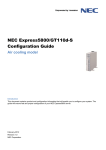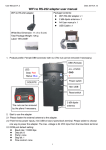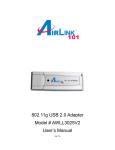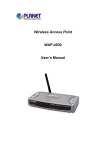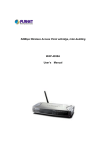Download EXSYS EX-6014WI
Transcript
EX-6014WI RS232 to WiFi Wireless Adapter, w/ Mounting Kit 1. Introduction Thank you for purchasing this RS232 to WiFi Wireless Adapter (hereinafter referred to as “WiFi-Adapter”), it is designed to communicate with RS232 serial devices over 802.11b/g compatible WiFi wireless connections. For the application where LAN cable is not preferred, the WiFi-Adapter delivers a simple, reliable and cost-effective network connectivity to enable your success. Features: One DB9 male RS232 connector to WiFi wireless network Supports 3-wire RS232 signals over the 5-pin terminal block connector Fully 2.4GHz, IEEE 802.11b/g compatible WiFi connectivity Protocols: ARP, IP, ICMP, UDP, TCP, DHCP, HTTP RS232 baud rate from 1200bps to 115.2Kbps Signals: TXD, RXD, RTS, CTS, DTR, DSR, DCD, RI Modes: TCP Server, TCP Client Supports Virtual COM Port drivers for Windows platforms Power Requirement: +5V~40VDC over the TB5 or +5VDC from the standard DC Jack 2. Connector Layout +5VDC Power Input DC Jack Push Button to Restore Default Settings Heartbeat LED 5-pin Terminal Blocks: 3-wire RS232 and +5~40V DC power input pins RS232 DB9M connector 1 RS232 to WiFi Wireless Adapter w/ Mounting Kit Mounting Kit Push Button to Restore Default Settings +5VDC Power Input DC Jack 5-pin Terminal Blocks: This pluggable terminal blocks integrates 2 wide-range DC power input pins and 3 RS232 signal pins. You can choose to power the WiFi-Adapter by either applying +5V on the DC Jack OR +5V~40V on the Terminal Blocks (but not both simultaneously). +5~40V DC GND GND RXD TXD Wide Range DC Power Input GND GND RXD (RS232, Output) TXD (RS232, Input) Push Button to Restore Default Settings: This switch can be used to reset the WiFi-Adapter to its factory default settings. Press and hold the button by a pen or similar tool for several seconds will restore the default settings immediately. DC Jack Power Connector: A 5V/2A AC adapter is supplied with this product. Please connect its power cable to this DC Jack connector. LED Indicator: The white color LED is a Heartbeat indicator, it is blinking when the WiFi-Adapter is powered up and function properly. 2 RS232 to WiFi Wireless Adapter w/ Mounting Kit 3. Installing WiFi-Adapter 1. Configure Web Access You can access the WiFi-Adapter by using either an access point with the SSID - Connect (with all encryption disabled, such as WEP & WPA) or a wireless card with Ad-Hoc mode (with SSID Connect). 2. Installing the WiFi-Adapter Hardware Connect your PC to the wireless network. Connect the power to the DC jack OR the terminal blocks of the WiFi-Adapter. Connect your serial device to DB9 connector OR the 5-pin terminal blocks. 3. Power up the WiFi Adapter When the WiFi-Adapter is powered up, the Heartbeat LED will be blinking and connect to the SSID Connect. If it cannot find a SSID of connect it will connect to the first unsecured network it found. Find the wireless network icon on your computer (on Windows, you'll find an icon that looks like 2 computers or a set of bars in your taskbar on the bottom right of your screen; Macs will have a wireless symbol in the top right). View available WiFi networks by either right-clicking the icon and selecting "View Available Wireless Networks" (Windows XP) or clicking the icon and selecting to "Connect or disconnect..." (Windows Vista). On Mac OS X and Windows 7, all you have to do is click on the WiFi icon to see the list of available networks. 3 RS232 to WiFi Wireless Adapter w/ Mounting Kit Choose the R2WiFi to connect to by clicking the "Connect" button (or just selecting it on Win7/Mac). Enter the security key -- if the wireless network is encrypted (with WEP or WPA), you'll be prompted to enter the network password or passphrase. This will be stored for you for next time, so you'll only have to enter it once. Start browsing the WiFi-Adapter! You should now be connected to the WiFi-Adapter; open your browser and visit the WiFi Adapter at 192.168.2.3 default IP address. Login using admin for both Username and Password. 4 RS232 to WiFi Wireless Adapter w/ Mounting Kit 4. Configuring the WiFi-Adapter In the Configuration menu, there are Basic, Advanced, Security, WiFi, WiFi Wizard and Status pages for the settings to work on this WiFi-Adapter. The most frequently used pages are Basic, Security, WiFi and WiFi Wizard pages. A. Basic setting page: Serial Settings: Please don’t leave Device Name blank, otherwise it will be rejected when you are saving the new settings by pressing “Apply” button afterward. Note: When you restoring the factory default settings by pressing the hardware push button at the rear panel of the WiFi-Adapter, the “Device Name” field will be cleared to Blank, please key in your Device Name, or you would not be able to save your settings. 5 RS232 to WiFi Wireless Adapter w/ Mounting Kit Network Settings: The Network Settings provides settings of the WiFi-Adapter including its IP/Socket, modes (TCP/Server, TCP/Client, UDP/Server or UDP/Client). 6 RS232 to WiFi Wireless Adapter w/ Mounting Kit B. Security Settings This page is to set login username, password and client IP control. Each field has its individual “Apply” button so you have to click it accordingly to save the corresponding settings. The factory default username is “admin” and its password is “admin”, too. The Accessible IP Settings is to allow the service only for the specific clients on list, there are 4 clients in maximum. To enable this function, please change the Control option from Disable to Enable as well. 7 RS232 to WiFi Wireless Adapter w/ Mounting Kit C. WiFi Settings This page is to set WiFi System Settings, WEP Encryption Key Settings, AES/TKIP Encryption Key Settings. There are some fields for the WiFi Advanced settings at the bottom of the page, please click “Apply” buttons next to the settings once you want to update the corresponding settings. 8 RS232 to WiFi Wireless Adapter w/ Mounting Kit WiFi General Settings WiFi Advanced Settings 9 RS232 to WiFi Wireless Adapter w/ Mounting Kit 5. Configuring the WiFi-Adapter to Access Point If you are using this WiFi-Adapter with an access point, we recommend you use the WiFi Wizard to guide you configure the WiFi settings. Click WiFi Wizard button, choose Infrastructure Network Mode, follow the Wizard’s instructions to complete the installation. 4. Examples for Using the WiFi Serial Port This section introduces an example to communicate with the serial port of this WiFi-Adapter. We are using a Terminal Emulation Program (such as HyperTerm or TeraTerm) to send data over the TCP/IP socket port and receive the loopback data from the same socket port. Similar to the HyperTerm example, the application software can read or write data on the TCP/IP socket port through Windows API. 1. Launch the HyperTerm utility, it will create a new connection, please type the connection name (type “TEST” in this case). 10 RS232 to WiFi Wireless Adapter w/ Mounting Kit 2. Enter the WiFi-Adapter’s IP address and port number: 3. Once the connection is built up successfully, the HyperTerm is ready to send or receive data, add a loopback connector on the DB9 connector or short the TXD and RXD pins on the 5-pin Terminal Blocks. Type “Hello!”, if the screen shows the same characters typed, then serial port is working well! 11 RS232 to WiFi Wireless Adapter w/ Mounting Kit 5. Using Virtual COM Port Drivers This WiFi-Adapter can work in ether Straight IP mode or Virtual COM Port mode. The Straight IP mode will be accessed through its TCP/IP socket port directly. The Virtual COM Port mode emulates a COM port by installing the CentosSEC Virtual COM Port driver. The Virtual COM Port software, CentosSEC, is an advanced software to map your serial port devices (COM ports) to Ethernet so they could be accessed from anywhere in the world (via Internet or LAN) as if it is attached directly to the remote PC. When the attached serial port device sends communication data it is actually transmitted over TCP/IP network and back from the network to your device. After installed, the driver allows Windows platform software, using standard API calls, to be used in an Ethernet application. Installing CentosSEC 1. Run the Centos_Setup.exe (right click “Centossec_Setup.exe” and choose “Run as an Administrator”) on the supplied CD, it was shipped in the following folder: 2. While installing the driver, please enter the password centos1104: 12 RS232 to WiFi Wireless Adapter w/ Mounting Kit 3. Follow the on-screen instructions to complete the Installation, you are ready to launch the software utility. Launch CentosSEC After installed the CentosSEC, you will need to navigate either to the Start Menu and locate the launcher in Programs submenu or double-click the shortcut created on the desktop. Please note that CentosSEC should be run as an administrator, for some Windows such as 2008, Vista and 7, their UAC (User Account Control) will limit the CentosSEC from working properly if you have only standard user privileges. In this case, please right-click the CentosSEC shortcut on the desktop, choose “Properties”, click “Compatibility” tab, enable the “Run this program as an administrator” option of the privilege level then click OK. Please see the following screen shot: 13 RS232 to WiFi Wireless Adapter w/ Mounting Kit 14 RS232 to WiFi Wireless Adapter w/ Mounting Kit Configuring CentosSEC 1. Running the CentoSEC, the following screen will appear, click the Help button will list the supported operations and details. You may need to click Add to create a new COM port then click Update All to save the settings. You don’t need to reboot the system after you pressing Update All button for any setting update. 2. To add a new COM port, it is important to set the Net. Protocol to RAW instead of TELNET for this WiFi-Adapter. After clicked Update All button, the status field should become “Available”. If it is “Registered”, it is not working properly. You need to review the problem. Usually it because you did not run as an Administrator. 15 RS232 to WiFi Wireless Adapter w/ Mounting Kit 3. You may use “Load list” button to get the preset configuration file (WiFi_RAW.dat) for the quick installation. 6. Operation Modes The WiFi-Adapter can function as a server or Client for TCP and UDP connections. The application scenarios include TCP Server mode, TCP Client mode, UDP mode and TCP Server/Client Paired mode (using 2 WiFi-Adapters with one in TCP Server mode and the other one in TCP Client mode). When in TCP Server/Client Paired mode, the 2 WiFi-Adapters are remotely connected without any need for extra software or drivers. 16 RS232 to WiFi Wireless Adapter w/ Mounting Kit 1. TCP Server mode: TCP Server mode provides the service at the TCP/IP socket port (factory default is set at 192.168.2.3 port 5000). The application software works as a client to this WiFi-Adapter. It can communicate via straight IP address directly or via a Virtual COM Port driver. TCP Server with Infrastructure Mode User Client Application Software access via 192.168.2.3 port 5000 TCP/IP Ethernet Serial Device PC’s IP: 192.168.2.4 WiFi-Adapter TCP Server at 192.168.2.3 port 5000 TCP Server with Ad-Hoc Mode User Client Application Software access via 192.168.2.3 port 5000 Serial Device WiFi-Adapter PC’s IP: 192.168.2.4 TCP Server at 192.168.2.3 port 5000 17 RS232 to WiFi Wireless Adapter w/ Mounting Kit The required settings for TCP Server as follows: 18 RS232 to WiFi Wireless Adapter w/ Mounting Kit 2. TCP Server/Client Paired mode: The TCP Server/Client Paired mode is designed for 2 WiFi-Adapters to be connected in back-to-back via WiFi wireless network. The TCP Server unit provides a service at 192.168.2.3 port 5000, the TCP Client unit should set its Destination IP to match the Server’s service port (192.168.2.3 port 5000). In this mode, the serial ports of the Server and Client are remotely connected without any software support. It’s very simple and straightforward. TCP Server/Client Paired with Infrastructure Mode TCP Server WiFi-Adapter TCP Client WiFi-Adapter TCP/IP Ethernet Serial Device Serial Device TCP Server/Client Paired with Ad-Hoc Mode TCP Server WiFi-Adapter TCP Client WiFi-Adapter Serial Device Serial Device 19 RS232 to WiFi Wireless Adapter w/ Mounting Kit The TCP required Server settings were mentioned above, the TCP Client settings as follows, please note that its Destination Host IP and Port need point to the TCP Server (192.168.2.3 port 5000 in this example). 7. RS232 Male-DB9 Pin Assignment and Wiring 9 Pins 1 2 3 4 5 6 7 8 9 20 Signal DCD RXD TXD DTR GND DSR RTS CTS RI RS232 to WiFi Wireless Adapter w/ Mounting Kit DB9(Male) RS232 to DB9(Male) RS232 Wiring DB9(USB Adapter) DB9(Serial Device) 1 DCD 1 DCD 2 RXD 2 RXD 3 TXD 3 TXD 4 DTR 4 DTR 5 GND 5 GND 6 DSR 6 DSR 7 RTS 7 RTS 8 CTS 8 CTS 8. TB5 Pin Assignment and Wiring 5-pin Terminal Blocks (TB5) Pin Assignment: 5- Wide Range DC Power Input 4- GND 3- GND 2- RXD (RS232, Output) 1- TXD (RS232, Input) +5~40V DC GND GND RXD TXD TB5 RS232 Cable Wiring: TB5 5 +5~40V DC 4 GND 3 GND 2 RXD 1 TXD (RS232 Device) 3 RTS 2 RXD 1 TXD 21 RS232 to WiFi Wireless Adapter w/ Mounting Kit 9. Product Specifications Type Specifications Ethernet IEEE 802.11b/g Wireless Compatible Data Rate IEEE 802.11b: 1, 2, 5.5 and 11Mbps IEE 802.11g: 6, 9, 12, 18, 24, 36, 48 and 54Mbps Supports TX rate auto fall-back mechanism Radio Frequency 2.412 ~ 2.472 GHz Channels Up to 13 channels. Profiles available include USA, Canada, Europe, Spain, France, Japan, China, Taiwan and “Other” (multiple countries) Modulations 802.11b: DSSS with DBPSK, DQPSK and CCK 802.11g: DSSS with DBPSK, DQPSK and CCK OFDM with BPSK, QPSK, 16QAM and 64QAM Antenna Integrated PCB Antenna RF Output Power 802.11b: 16.5 ±1dBm 802.11g: 14 ± 1dBm @ 54 Mbps; 15 ± 1dBm @ 48 Mbps; 16 ± 1dBm @ 6 ~ 36 Mbps Receive Sensitivity 802.11b: 16.5 ±1dBm 802.11g: 14 ± 1dBm @ 54 Mbps; 15 ± 1dBm @ 48 Mbps; 16 ± 1dBm @ 6 ~ 36 Mbps 802.11b: -92dBm @ 1 Mbps; -90dBm @ 2 Mbps; -89dBm @ 5.5 Mbps; -85dBm @ 11 Mbps 802.11g: -82dBm @ 6 Mbps; -82dBm @ 9 Mbps; -82dBm @ 12 Mbps; -82dBm @ 18 Mbps; -79dBm @ 24 Mbps; -76dBm @ 36 22 RS232 to WiFi Wireless Adapter w/ Mounting Kit Mbps; -71dBm @ 48 Mbps; -70dBm @ 54 Mbps RS232 Serial Port Connectors 9-pin D-type male (DB9M, full signal) and 5-pin terminal blocks (TB5, 3-wire signal). RS232 Signals DB9M: TXD, RXD, RTS, CTS, DTR, DSR, DCD, DSR, RI, GND TB5: TXD, RXD, GND Baud Rate: 1200bps to 115.2Kbps Data bits 5, 6, 7, 8 Parity: None, Even, Odd Stop bits 1, 1.5, 2 Flow Control Hardware RTS/CTS, Software XON/XOFF Setup Options Web Configuration Configuration Modes Straight IP (TCP or UDP Sockets) Virtual COM Port TCP Server/Client Paired Configuration Method Any web browser via built-in web server Security 802.11i security: WEP-64/128, TKIP (WPA-PSK) and AES (WPA2-PSK) Accessories Wall mount kit and Optional DIN RAIL Clips Power Requirements Power Input 5V DC (via DC Jack) 5V~40V DC (via TB-5) 23 RS232 to WiFi Wireless Adapter w/ Mounting Kit Power Consumption 250mA @ 5V DC Mechanical Specifications Material Plastic Dimensions 3.24”(L)x1.74”(W)x0.87”(H) (8.23 x 4.42 x 2.22 cm) Gross Weight 9065g (0.20lb) Environmental Operating Temperature 0 to 558C (32 to 1318F) Storage Temperature -20 to 858C (-4 to 1858F) Operating Humidity 5 to 95% RH 24
























